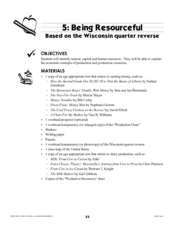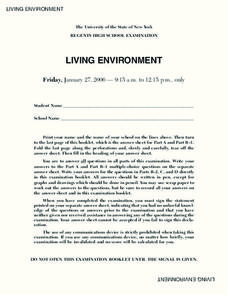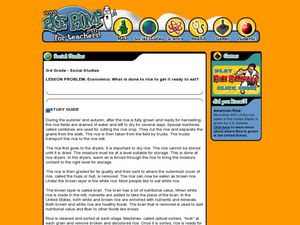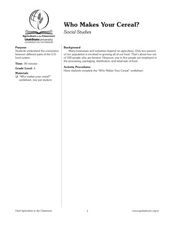Curated OER
The Importance of Imports
Learners explore world trade by examining items they find at home and listing countries those items came from. Data is displayed on a map and charted according to continent. They discuss how products are transported.
Curated OER
Shopping the Sunday Circular
Pupils demonstrate an understanding of price-per-unit mathematics. In this computation lesson, learners accurately figure the unit price of grocery items. They create a chart and record the item, the price, the size and the cost per item.
Simply Worksheets
Food Chain Word Scramble
In this food chain words instructional activity, students unscramble the food chain words and then find a hidden word. Students unscramble 14 words total.
Curated OER
Consumer Borrowing and Spending
Credit can be confusing for teens, some of whom are already using credit cards. Clear up misconceptions with this group research activity which has a solid outline with a lot of room to adjust to your needs and resources. Groups are...
Curated OER
An International Dinner Table
Students investigate the origins of several crops eaten in the United States today. The facto0rs that influence consumer choices and the influences on the American population as to eating preferences are discussed in this lesson.
Curated OER
Being Resourceful: Wisconsin quarter reverse
If your class understands goods and services then they'll be ready for this lesson on various resources. After reading a series of books and engaging in class lecture and discussion, pupils will fill out worksheets. They will list...
Curated OER
Louisiana Riches
Introduce your class to the concept of economics, resources, and the interaction between consumers and producers. This slide show presents simple definitions of each concept to build vocabulary. Note: This presentation focuses on goods...
Curated OER
Do You Really Need It?
A large part of understanding personal finance and economics is grasping the concept of wants and needs. This presentation provides students with basic yet effective definitions of wants, needs, and how they effect advertisements and...
Curated OER
Living Environment
In this environment lesson young scholars complete a series of multiple choice and short answer questions on the food chain, DNA, cellular reproduction.
Curated OER
Setting Up Shop
Seventh graders investigate what goes in to starting a retail store. In this business economics lesson, 7th graders brainstorm products they would like to sell and use magazines, newspapers and real estate listings to bring their store...
Curated OER
A Day Without Agriculture
Second graders define and create a list of agricultural products. In this producers and consumers lesson, 2nd graders participate in a contest to find as many types of agriculture as they can. The student who comes up with the best...
Curated OER
Agriculture Pays
Second graders role play one of the jobs related to agriculture and explain their role in getting one of the five "f's" of agriculture to the consumer. In this agriculture lesson, 2nd graders are assigned a role and a commodity. Each...
Curated OER
Forest Food Chains and Webs
Students explore forest ecological systems. In this ecology lesson plan, students classify forest plants and animals according to their ecological roles. Students play a related vocabulary guessing game. Students choose a card on which...
Curated OER
Prairie Food Chains & Webs
Students complete a food chain. In this ecosystem lesson, students learn about producers, consumers and decomposers. Students identify herbivores, carnivores and omnivores and complete two worksheets.
Curated OER
Economics: What is done to rice to get it ready to eat?
Third graders create a map showing the journey of rice from the field to the grocery store. For this agriculture lesson, 3rd graders discover and map the process of harvesting and preparing rice to be packaged and shipped to sell to...
Curated OER
Consumer Confusion: Wants versus Needs and Gandhi's Wisdom
Fourth graders create graphs to illustrate consumer consumption throughout the world. In this consumer lesson plan, 4th graders also discuss wants and needs around the world, and consider Gandhi's opinion on material possessions as they...
Curated OER
Ecosystem Game
Students examine the ecosystem by playing a game. In this ecosystem lesson, students are put into groups of decomposers, consumers, and producers. Students create a list of animals that fit into each group and items that represent...
Curated OER
How Much Money?
Sixth graders count money. In this money lesson, 6th graders count sets of coins and dollar bills. During specified activities, they total orders and calculate the amont of change a customer should receive. Students take turns...
Curated OER
Ecology Study Guide
In this ecology study guide, students fill in a table about producers, consumers and decomposers, they draw the water cycle, they fill in diagrams about cell respiration, the food pyramid, protein synthesis and nitrification, population...
Curated OER
Price
First graders complete worksheets on producers and consumers and the total price of a group of items. In this price lesson plan, 1st graders read the book A Dollar for Penny in order to understand price, producers, and consumers, and...
Curated OER
Who Makes Your Cereal?
Fourth graders investigate how cereal is produced. In this agricultural lesson, 4th graders discuss where ingredients in cereal come from. Students use picture cards to identify the steps in producing cereal.
Curated OER
Ecosystem Tumble
Learners create visual representations of ecosystems. In this ecology lesson plan, students discuss the interdependence of plants and animals in various ecosystems. Learners cut pictures from magazines and glue them on sturdy blocks. ...
Curated OER
Biodiversity in an Estuary
Young scholars investigate the biodiversity in estuaries. In this estuary lesson plan, students use Google Earth to explore the Rookery Bay National Estuarine Research Reserve. They produce a biodiversity concept map and portray the life...
Curated OER
Transfer of Energy
In this transfer of energy worksheet, young scholars complete a graphic organizer that shows the relationship between the sun, producers, first order consumers and second order consumers. They describe why it is important to understand...


